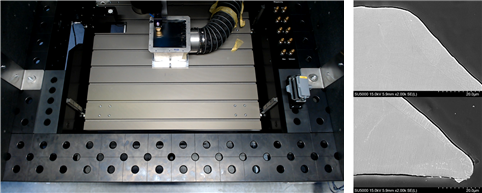The thickness of the bipolar plate is decreasing as fuel cells used in vessels and aircraft become lighter and more efficient. In this context, a worldwide R&D project has created a laser machining method for thin bipolar plates, which can assist in improving the production efficiency and quality of fuel cells.
 Image showing how laser machining works, and the quality of the cut section. Image Credit: KIMM
Image showing how laser machining works, and the quality of the cut section. Image Credit: KIMM
By using a scanner that enables laser welding and cutting of materials for 0.075 mm thick bipolar plates for fuel cells, a team of researchers from the Korea Institute of Machinery and Materials, an institute under the jurisdiction of the Ministry of Science and ICT, K-Lab, a Korean small and medium-sized enterprise, and Germany’s Fraunhofer Gesellschaft and BBW Lasertechnik GmbH created novel 2D on-the-fly composite equipment.
The interdisciplinary research team, led by principal researcher Su-jin Lee of the KIMM Department of Industrial Laser Technology, concentrated on the needs of fuel cell manufacturers, who seek simultaneous high-quality cutting and welding of large-scale thin plates in varied forms.
The joint research team was able to create a Top-Lamp composite processing machine by cross-coupling the cutting gas output nozzle to the stage using traditional technologies where the stage and scanner move simultaneously. This machine is capable of welding and cutting large areas (400 mm × 400 mm or larger) in a variety of forms.
Additionally, the research team created and used a feature that automatically corrects the work area through the same axle of the scanner and the vision system of the exterior angle in real-time to preserve machining accuracy.
With the help of this function, a technology has been implemented that allows for the correction of the diameter of the nozzle throat’s central location and the irradiation of the laser beam within 3 mm of the diameter of the nozzle during the process.
The hybrid composite equipment, which can execute high-speed welding and nozzle cutting simultaneously, has been installed and managed by BBW Lasertechnik GmbH, a German partner institution.
It has been difficult to properly regulate the form of the material using standard 2D on-the-fly technology due to the change in speed induced by acceleration or deceleration at the point of turnaround (cornering) while the material is being processed.
Furthermore, because it has been difficult to make changes to the machining process, it has been important to increase its quality. However, using separate equipment for welding and cutting has increased processing times and costs because it is difficult to link cutting gas nozzles to traditional high-speed scanners.
By lowering cross-coupling errors through a more exact position correction by the scanner’s vision system, the newly developed technology contributes to improving machining quality. To improve cutting quality, the cutting gas nozzle can also be connected separately to the scanner or another stage.
The vision system also adjusts the center point for the nozzle throat’s exposure to the laser beam. This enables simultaneous high-speed welding and partial cutting, which aids in saving costs and processing time.
The German research team is also expecting that the latest technology, developed through international joint research, will be applicable to various sectors. The newly developed technology is meaningful in that it can respond to the demands from the fuel cell market for the improvement of machining quality as the thickness of bipolar plates for fuel cells becomes increasingly thinner.
Su-jin Lee, Principal Researcher, Department of Industrial Laser Technology, Korea Institute of Machinery and Materials
This study, however, was supported by the Ministry of Trade, Industry, and Energy’s worldwide co-development project for the “development of advanced laser machining technologies for the manufacture of fuel cells.”
One of the organizations involved in the research, the German Fraunhofer Gesellschaft, and KIMM signed a Memorandum of Understanding (MoU) in May 2022 to expand international cooperation and foster long-term networking and collaboration among researchers in relevant fields.
Journal Reference:
Song, D., et al. (2023) Effects of Beam Shape on the Microstructures and Mechanical Properties during Thin-Foil Laser Welding. Metals. doi:10.3390/met13050916.